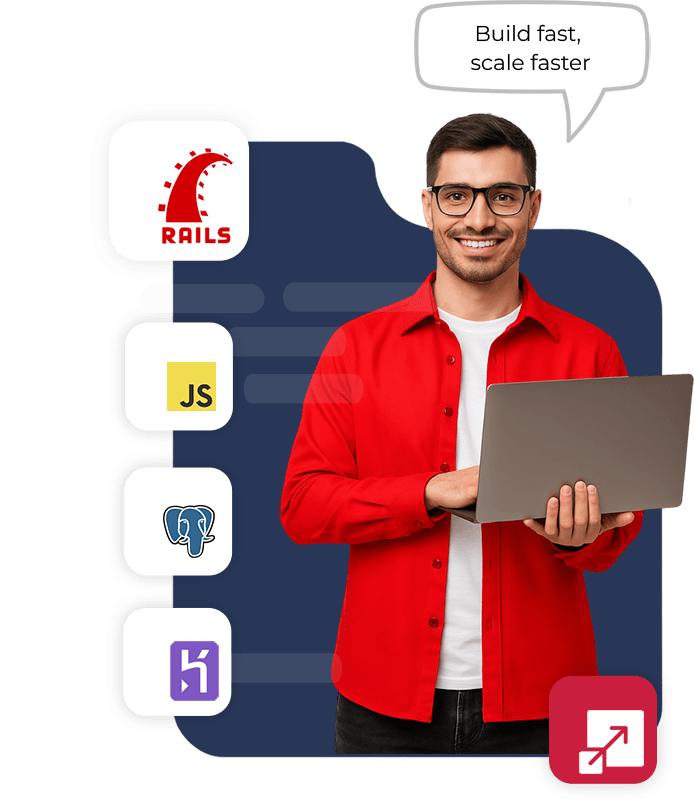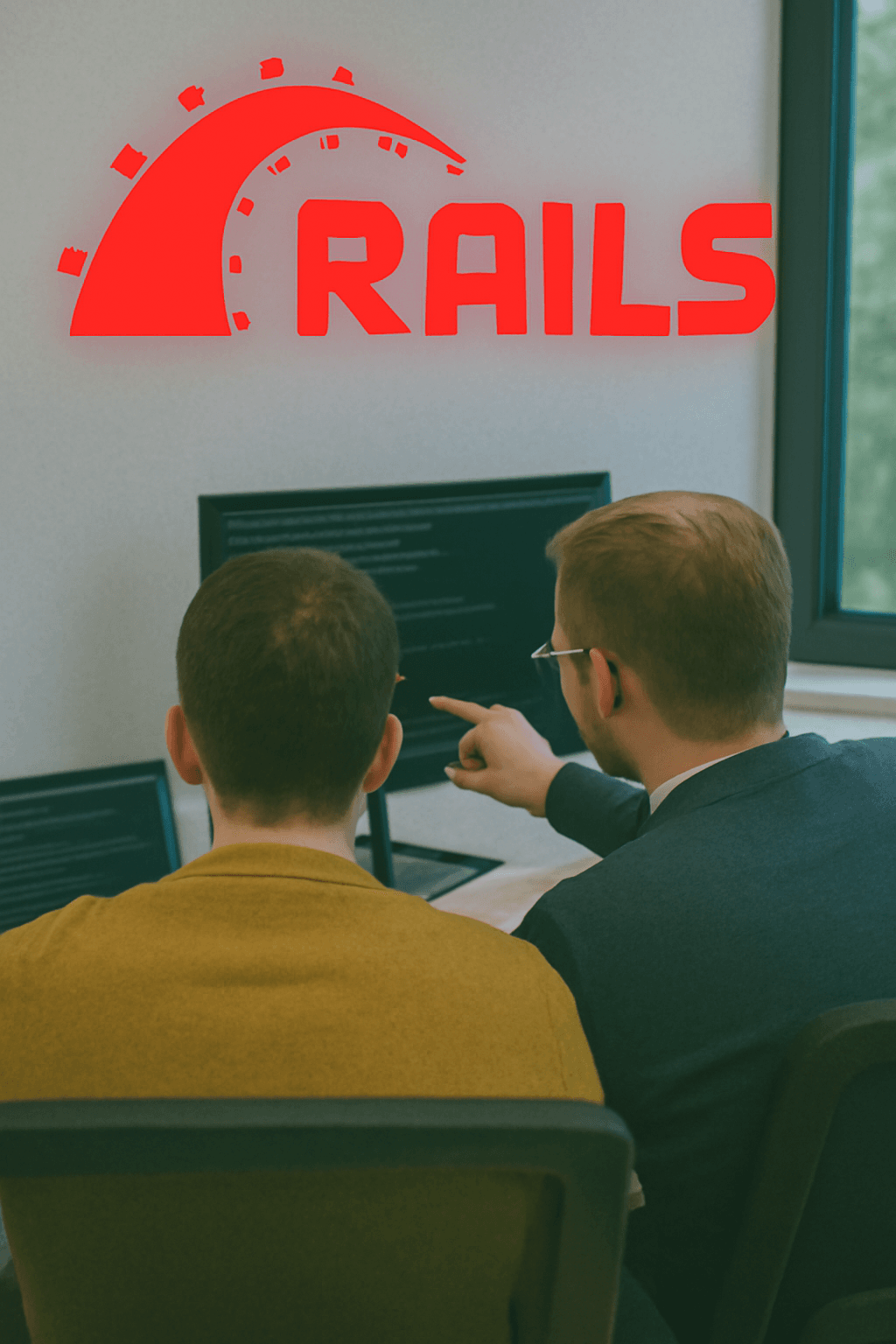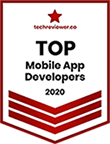
Top CI/CD Tools for Scalable Web Apps
Read how CI/CD streamlines code integration, testing, and deployment—boosting speed, quality, and scalability in modern software development.
Regular updates and clear communication
Confidentiality with legal protection
No hidden fees, transparent billing
24/7 dedicated support
Flexible hours based on your timezone
Scalable teams for your needs

Ruby on Rails (RoR) is a powerful, open-source web framework that emphasizes convention over configuration, making it ideal for building applications fast without sacrificing scalability or maintainability. Ruby on Rails is trusted by brands for fast & maintainable applications.
RoR allows developers to separate concerns cleanly, encouraging better code organization and faster iteration cycles through its MVC architecture. Ruby on Rails supports clean code, rapid prototyping, and a vibrant ecosystem of gems (plugins).
Build highly tailored, scalable, and secure web applications with RoR—perfect for startups, enterprises, and SaaS platforms.
Expert in frontend & backend development
Affordable, high-quality solutions
Fast project delivery
Efficient troubleshooting & debugging
Adaptable to changing needs
Clear, efficient communication

Our RoR experts leverage modern technologies, tools, and libraries to build high-performance, scalable, and secure web applications.
The team delivered high quality work that met our expectations in terms of design and functionality.
We help you access skilled, reliable ROR Developers who bring clarity, speed, and scalability to your projects — so you can focus on results, not resourcing.
Dappinity provides expert ROR Developers offering scalable, innovative, and client-focused solutions while ensuring high quality and timely project delivery.
The dedicated ROR Developers team at Dappinity delivers innovative, scalable, and secure solutions, ensuring seamless collaboration and future ready applications.

Tell us what you need - tech stack, experience, timelines.

We send you pre-screened developers matched to your needs.

You interview. You decide. Start in as little as 72 hours.

Easily scale up or down. We stay flexible as you grow.
Selecting the right engagement model is essential when hiring Ruby on Rails (RoR) developers to ensure the project is completed within budget and time constraints. Here’s how different engagement models apply to RoR development:
Full-time RoR developers are ideal for long-term, complex web applications that require regular updates and ongoing maintenance. If you’re building an enterprise-grade platform, e-commerce site, or SaaS product, a full-time RoR developer ensures consistent progress, code quality, and reliable collaboration, making them well-suited for projects with evolving requirements.
Part-time RoR developers are a good fit for projects that don't require constant work but need regular updates, maintenance, or the addition of new features. They can manage ongoing tasks like improving functionality, optimizing performance, or fixing minor bugs, allowing you to keep your app fresh without the need for a full-time commitment.
Hourly RoR developers are perfect for short-term, specific tasks. Whether you need to implement a feature, resolve performance issues, or work on a bug fix, hourly developers offer flexibility and allow you to pay for only the hours worked. This model works well for minor tasks or temporary needs without locking you into a long-term contract.
Project-based developers are ideal when your Ruby on Rails project has clearly defined goals, deliverables, and deadlines. Whether you’re developing a custom content management system (CMS), an e-commerce platform, or an API, project-based developers focus on completing the work within the agreed-upon timeframe and budget, ensuring the project is delivered with a set scope.
Choosing the right methodology ensures your Ruby on Rails project is delivered on time, within budget, and with high-quality outcomes. Here’s how different methodologies apply to RoR development:
Agile is highly beneficial for Ruby on Rails projects, particularly when requirements evolve frequently or the project scope is flexible. Agile focuses on iterative development, where features are developed and released in small, manageable chunks (called sprints). RoR’s ability to rapidly iterate and the community’s focus on collaboration make Agile a natural fit for RoR development.
Scrum, a specific Agile framework, divides the project into sprints and focuses on delivering small, incremental features that can be reviewed and adjusted regularly. Scrum works well for larger projects, such as SaaS platforms, e-commerce applications, or complex RoR web apps with multiple integrated services. It helps manage the development process and allows teams to focus on specific goals in short cycles.
Waterfall is a more traditional methodology, suitable for smaller, simpler projects where requirements are stable and well-defined. If you’re building a simple website or a small web application with few moving parts, Waterfall ensures a linear, structured approach from planning to deployment. It’s less flexible but effective for straightforward RoR applications with fixed features.
Ruby on Rails developers bring a wide range of expertise to your project, making it essential to align their skills with your tech stack needs. Here’s how RoR fits within modern tech ecosystems:
Built-in Security Features: Ruby on Rails includes built-in security features such as SQL injection protection, cross-site scripting (XSS) prevention, and CSRF (Cross-Site Request Forgery) protection to help secure web applications from common threats.
Maintaining high code quality is essential for building scalable and maintainable Ruby on Rails applications. Here’s how RoR developers ensure top-quality code:
Code reviews ensure consistency and adherence to best practices. RoR developers follow guidelines for naming conventions, object-oriented programming principles, and security standards. Regular code reviews help identify potential bugs early and maintain high standards throughout the development cycle.
Tools like RuboCop are used to enforce coding standards and prevent common errors. These tools help ensure that your RoR code is clean, consistent, and follows best practices for readability and maintainability.
Continuous Integration and Continuous Deployment (CD) are used to automate the process of testing, integrating, and deploying the application. RoR developers leverage CI/CD pipelines with tools like Jenkins or GitLab CI to streamline testing and ensure that updates are delivered quickly and reliably.
It’s important for RoR developers to sign non-disclosure agreements (NDAs) to protect the confidentiality of your project and any proprietary code. Contracts should also clearly define ownership of the RoR code, intellectual property, and other assets developed during the project.
Storing RoR code securely in private repositories on platforms like GitHub, Bitbucket, or GitLab is crucial. These platforms provide version control, collaboration tools, and security features like two-factor authentication (2FA).
RoR developers should follow role-based access control (RBAC), ensuring that only authorized individuals have access to critical code and resources. Access to the codebase should be revoked after project completion to prevent unauthorized use.
Contracts should explicitly define that all code, scripts, and assets developed during the RoR project are owned by your business. Use “Work for Hire” clauses to ensure that intellectual property rights are clearly assigned to your organization.
When choosing between a freelancer and a dedicated RoR developer, consider your project’s complexity, scale, and long-term needs:
Freelancers are ideal for small projects or specific tasks, such as adding a new feature, optimizing performance, or fixing bugs. They are cost-effective and provide flexibility but may lack the long-term availability and commitment that larger projects require.
A dedicated RoR developer is the best option for larger, ongoing projects. For instance, building a complex SaaS platform, enterprise web application, or custom CMS would benefit from a dedicated developer's deep involvement, consistent collaboration, and ability to handle complex requirements.
Bring your web application vision to life with seasoned Ruby on Rails developers from Dappinity. Whether you're building an MVP, scaling an existing platform, or modernizing a legacy system, our RoR experts ensure clean architecture and optimal performance.
 Transparency
Transparency Strict Privacy Assurance with NDA
Strict Privacy Assurance with NDA Talented Team of Developers
Talented Team of Developers 12 Months Free Support
12 Months Free Support Smooth Collaboration & Reporting
Smooth Collaboration & Reporting On time Delivery, No Surprises
On time Delivery, No Surprises Efficient & Adaptive Workflow
Efficient & Adaptive WorkflowRuby on Rails (RoR) is a server-side web application framework written in the Ruby programming language. It follows the Model-View-Controller (MVC) architectural pattern and emphasizes convention over configuration (CoC) and don't repeat yourself (DRY) principles. RoR is popular for its simplicity, speed of development, and ability to build scalable and maintainable web applications quickly. It's commonly used for building content management systems, e-commerce websites, and social media platforms.
Ruby on Rails offers several key features that make it popular among developers:
1. Convention Over Configuration (CoC): Rails uses sensible defaults for the structure of an application, allowing developers to focus on the business logic rather than configuration.
2. Don't Repeat Yourself (DRY): Rails promotes code reusability, reducing redundancy by abstracting common operations.
3. ActiveRecord ORM: Rails uses ActiveRecord to simplify database interactions and allow developers to use Ruby code for querying and managing databases.
4. Scaffolding: Rails provides built-in tools to quickly generate boilerplate code for models, controllers, and views, speeding up the development process.
5. RESTful Architecture: RoR uses REST (Representational State Transfer) principles to organize the structure of web applications, making them easier to scale and maintain.
ActiveRecord is an Object-Relational Mapping (ORM) library in Rails that connects objects in Ruby to database tables. It provides a simple, intuitive way to interact with databases using Ruby code instead of writing SQL queries. ActiveRecord automates much of the database management process, including creating, reading, updating, and deleting records (CRUD operations), and supports database migrations to easily modify the database schema.
Migrations are a way to manage changes to the database schema over time. They allow developers to define changes to the database (like adding or removing tables, columns, or indexes) in a Ruby file, and then apply those changes to the database using Rails commands. Migrations help ensure that the database schema stays consistent across different environments (e.g., development, production).
The MVC architecture in Ruby on Rails organizes an application into three main components:
1. Model: Represents the data and the business logic of the application. It interacts with the database and manages the data.
2. View: The user interface (UI) component that displays the data to the user. It renders the HTML, CSS, and JavaScript to be shown in the browser.
3. Controller: Acts as the intermediary between the model and view. It handles user input, updates the model as needed, and determines which view to display.
The MVC pattern helps organize code, making it easier to maintain and scale.
Some best practices for Ruby on Rails development include:
1. Follow the DRY principle: Avoid code duplication by reusing code and creating reusable components.
2. Use Partial Views for Code Reusability: Break down your views into smaller reusable parts to keep your codebase clean.
3. Write Tests: Use RSpec or Minitest for testing your application’s functionality to ensure code quality and catch bugs early.
4. Follow RESTful Design: Structure your app’s URLs and controllers to follow REST conventions for better scalability and maintainability.
5. Use Gems Wisely: Leverage the power of Ruby on Rails gems to speed up development but avoid unnecessary dependencies that can bloat your app.
Authentication and authorization can be managed in Ruby on Rails using popular gems like:
1. Devise: A flexible and full-featured authentication solution that handles user sign-up, login, password recovery, and session management.
2. OmniAuth: A gem for integrating third-party authentication (like Google, Facebook, etc.) into your app.
3. Pundit: A gem used for handling user roles and permissions (authorization). It defines policies that control access to resources.
Using these tools, developers can easily implement secure user authentication and fine-grained access control for their apps.
Rails provides several tools and libraries for handling background jobs, including:
1. Sidekiq: A popular and highly scalable background job processing library that uses Redis to manage job queues.
2. Resque: Another background job processing library that uses Redis and supports job retries and scheduling.
3. ActiveJob: A built-in framework in Rails that abstracts the process of creating and managing background jobs. It can be used with libraries like Sidekiq or Resque.
Background jobs in Rails are typically used for tasks like email sending, file processing, and other long-running operations.
There are several ways to deploy Ruby on Rails applications:
1. Heroku: A cloud platform that simplifies the deployment of Ruby on Rails applications. It offers free and paid plans, with features like automatic scaling and integrated databases.
2. AWS (Amazon Web Services): Using services like EC2, RDS, and Elastic Beanstalk, you can deploy Rails apps to AWS for greater control over infrastructure.
3. DigitalOcean: A cloud provider that offers virtual private servers (Droplets) for deploying Rails apps, often used by developers for its simplicity and cost-effectiveness.
4. Capistrano: A deployment automation tool for Rails applications that simplifies deploying to your own servers or cloud infrastructure.
Hiring a Ruby on Rails developer from Dappinity is easy and streamlined:
1. Define Your Requirements: Share the specific needs of your project, including any necessary tech stack, timelines, and features.
2. Get a List of Pre-Vetted Developers: Dappinity provides a curated list of experienced RoR developers with the right skills.
3. Interview and Select: Choose the best developer by interviewing them to assess their experience and fit for your project.
4. Onboard and Start Development: Once you’ve selected a developer, onboard them and begin working on your Ruby on Rails project with ongoing support.







